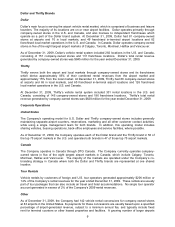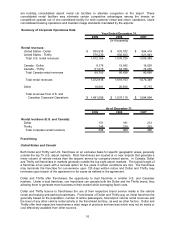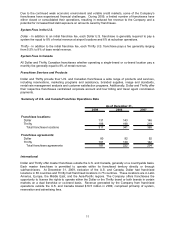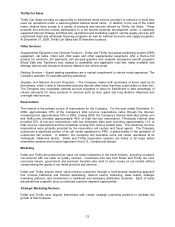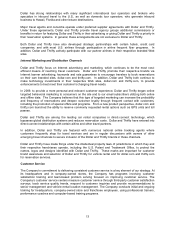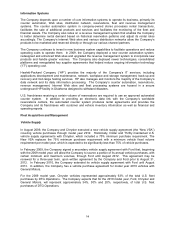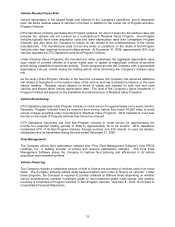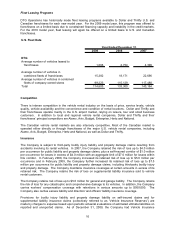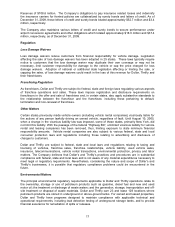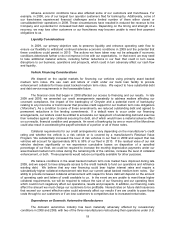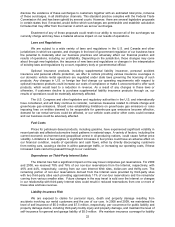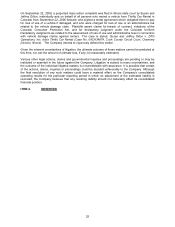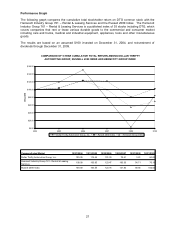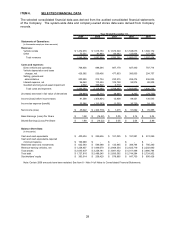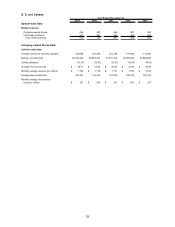Thrifty Car Rental 2009 Annual Report Download - page 20
Download and view the complete annual report
Please find page 20 of the 2009 Thrifty Car Rental annual report below. You can navigate through the pages in the report by either clicking on the pages listed below, or by using the keyword search tool below to find specific information within the annual report.Adverse economic conditions have also affected some of our customers and franchisees. For
example, in 2008, one of our largest tour operator customers filed for bankruptcy. Additionally, some of
our franchisees experienced financial challenges and a limited number of them either closed or
consolidated their operations in 2009. These circumstances have resulted in reduced fee revenue to the
Company and a potential for increased bad debt exposure. Depending on the timing and strength of a
recovery, we may lose other customers or our franchisees may become unable to meet their payment
obligations to us.
Liquidity Considerations
In 2009, our primary objective was to preserve liquidity and enhance operating cash flow to
ensure our flexibility to withstand continued adverse economic conditions in 2009 and the potential that
these conditions could persist in 2010. The actions we have taken may not be adequate if economic
conditions deteriorate further or do not improve in line with our expectations. In that event, we may need
to take additional material actions, including further reductions in our fleet that could in turn cause
disruptions to our business, operations and prospects, which could in turn adversely affect our cash flow
and liquidity.
Vehicle Financing Considerations
We depend on the capital markets for financing our vehicles using primarily asset backed
medium term notes. We use cash and letters of credit under our bank loan facility to provide
enhancement collateral for these asset backed medium term notes. We expect to have substantial debt
and debt service requirements in the foreseeable future.
The financial crisis that began in 2008 affected our access to financing and our results. In late
2008 and 2009, we amended our credit arrangements repeatedly to address matters affecting our
covenant compliance, the impact of the bankruptcy of Chrysler and a potential event of bankruptcy
relating to any monoline or bond insurer that provides credit support for our medium term note obligations
(“Monoline”). As a condition to some of these amendments, we reduced outstanding debt and agreed to
permanent reductions in the lending commitments. If a default were to occur under our financing
arrangements, our lenders could be entitled to accelerate our repayment of outstanding debt and exercise
their remedies against any collateral securing the debt, all of which would have a material adverse effect
on our results, financial condition and prospects. An event of bankruptcy by one or more of the Monolines
could also result in accelerating the payoff schedule of a portion or all of those notes.
Collateral requirements for our credit arrangements vary depending on the manufacturer’s credit
rating and whether the vehicle is a risk vehicle or is covered by a manufacturer's Residual Value
Program. We substantially increased the level of risk vehicles in our fleet in 2009 and expect that risk
vehicles will account for approximately 90% to 95% of our fleet in 2010. If the residual value of our risk
vehicles declines significantly or we experience cumulative losses on disposition of a specified
percentage of our fleet, we could be required to increase the monthly depreciation payments under our
asset backed medium term notes during the remaining life of the vehicles, increase the level of collateral
enhancement, or both. These payments would reduce our liquidity available for other purposes.
We believe conditions in the asset backed medium term note market have improved during late
2009, and we expect to have adequate access to the credit markets to fund our operations and refinance
existing debt. We believe that any new financing could bear higher interest rates and require a
substantially higher collateral enhancement rate than our current asset backed medium term notes. Our
ability to provide increased collateral enhancement with respect to future debt will depend on the amount
of operating cash and letters of credit available to us. In the event we are unable to meet these higher
collateral requirements, we will be required to reduce the size of our financing and our operating fleet,
which could in turn negatively affect our operations, results and prospects. In addition, our financing costs
affect the amount we must charge our customers to be profitable. Interest rates on future debt issuances
that exceed our current effective rates could adversely affect our results if we are unable to pass those
costs through to our customers or if we lose customers to competitors due to increased rental rates.
Dependence on Domestic Automotive Manufacturers
The domestic automotive industry has been materially adversely affected by recessionary
conditions in 2008 and 2009, with two of the three manufacturers restructuring their operations under U.S.
19


